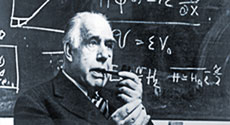Niels Bohr Lecture by Mark Saffman
ABCs of Rydberg physics: from Atoms to Bottles to Computers
Abstract: One hundred years ago Quantum Mechanics was invented and applied first to understanding the structure of atoms. A hundred years later, the tables have turned, and atoms are a tool for gaining a deeper understanding of quantum mysteries.
Arrays of atoms with interactions provided by highly excited Rydberg states provide a setting where atomic physics takes on extreme properties which are being harnessed for quantum applications. In the last few years remarkable progress has been achieved with neutral atom arrays, and they are now established as a leading platform for quantum information processing.
In this talk I will delve into aspects of Rydberg physics that endow these highly excited atoms with remarkable properties and show how we can trap, control, and program their quantum states.
About the speaker:
Mark Saffman is an experimental physicist working in the areas of atomic physics, quantum and nonlinear optics, and quantum information processing.
His research team was the first to demonstrate a quantum CNOT gate for the deterministic entanglement of a pair of neutral atoms. This was done using dipole mediated interactions between highly excited Rydberg atoms. He is currently developing scalable arrays of neutral atoms for quantum computation, communication, and sensing applications.
He is the Johannes Rydberg Professor of Physics at the University of Wisconsin-Madison and has been recognized with an Alfred P. Sloan fellowship, a Vilas Associate Award, the WARF Innovation Award, and is a fellow of the American Physical Society, and Optica.
He has been active in professional service including two decades as an Associate Editor at the Physical Review, and is the director of The Wisconsin Quantum Institute. He also serves as Chief Scientist for Quantum Information at Infleqtion, Inc.
Coffee, tea and cake will be served outside Aud. 3 at 15:45
 Niels Bohr Lectures er en engelsk-sproget foredragsrække på Niels Bohr Institutet med kendte forskere fra hele verden.
Niels Bohr Lectures er en engelsk-sproget foredragsrække på Niels Bohr Institutet med kendte forskere fra hele verden.
Foredragene holdes cirka 10 gange om året og er offentlige. De er for studerende og ansatte ved Niels Bohr Institutet samt andre med interesse for at høre om videnskabelig forskning i verdensklasse. Foredragene holdes på et ikke-teknisk niveau, hvor de kan forstås af alle med en baggrundsviden, der svarer til de første år på fysikstudiet.
Tidspunkt og sted: Hvis intet andet er anført, finder foredragene sted kl. 15.15 i Margrethe Bohr Salen, Niels Bohr Bygningen, 2200 København N. Kaffe og kage serveres en halv time inden foredraget starter.
The lectures are public and held about 10 times a year. The lectures are for students and staff at the Niels Bohr Institute and others interested in worldwide scientific research. The lectures are held on a non-technical level where they can be understood by anyone with a background similar to the first year of physics study.
Time and place: Unless otherwise specified, the lectures take place at. 15.15 in Margrethe Bohr Salen, Niels Bohr Bygningen, 2200 Copenhagen N. Coffee and cake will be served half an hour before the lecture starts.
